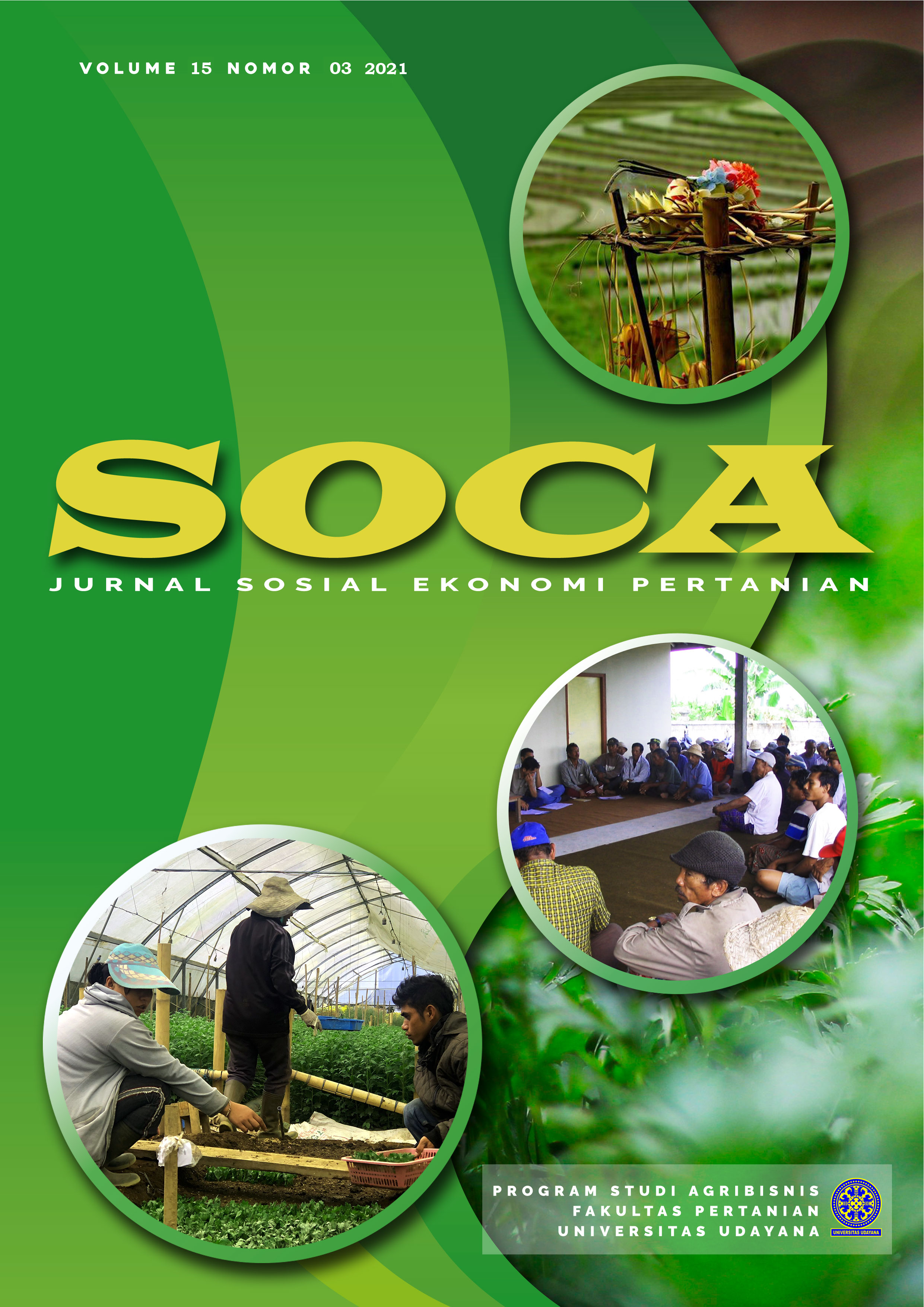The Marketing Strategy of Waste-Processed Craft Product in Pontianak City
Abstract
Pontianak city produced 400 tons of waste every day. The prevention of waste had been done in various ways; one of them was the utilization of waste by 8 waste banks to be used as craft products with an economic value. The aim of the research was to formulate alternative priority marketing strategies for processed waste craft products in Pontianak. The research method that used was descriptive qualitative methods, surveys and interviews with key informants to obtain SWOT criteria and alternative strategies. This research used primary and secondary data, primary data obtained from interviews and surveys that included waste banks data and respondent data, secondary data included waste production in Pontianak City, waste banks in Pontianak City. The data analysis used the combination of Analytical Hierarchy Process (AHP) and Strength Weakness Opportunities Threats (SWOT). The research results showed that the alternative priority for the marketing strategy of processed waste products was the strategy to improve Human Resources (0.462), such as product innovation, conducted comparative study with UKM (small-medium enterprises), made observations of products that people were interest in; information and technology improvement strategies (0.403), such as recruited and trained employees to understand information technology; institutional improvement strategies (0.135), such as upgraded and focused group discussions in the Waste Bank Forum, managed the requirements for marketing in supermarkets
Downloads
References
Ananda, A. D., & Susilowati, D. (2017). Pengembangan Usaha Mikro Kecil Dan Menengah (UMKM) Berbasis Industri Kreatif Di Kota Malang. Jurnal Ilmu Ekonomi, 12(3), 120-142.
Astari, S. D., & Warmadewanthi, I. (2010). Kajian Model Pengelolaan Sampah Berbasis Masyarakat Di Kecamatan Wonocolo Kota Surabaya. Manajemen Teknologi, 9(1), 101-109.
Bekraf. (2019, January 2019). Data Statistik dan Hasil Survei Ekonomi Kreatif. Retrieved from bekraf: https://www.bekraf.go.id/pustaka/page/data-statistik-dan-hasil-survei-ekonomi-kreatif-2016
Boon, C., Hartog, D. D., & Lepak, D. P. (2019). A Systematic Review of Human Resource Management Systems and Their Measurement. Journal of Management, 45(6), 2498-2537.
BPS. (2019). Perkembangan Pariwisata dan Transportasi Kalimantan Barat September 2019. Retrieved from pontianakkota.bps: https://pontianakkota.bps.go.id/pressrelease/2019/11/06/609/kunjungan-wisatawan-mancanegara-di-provinsi-kalimantan-barat-pada-september-2019-mencapai-5-795-kunjungan.html
Fatmawati, & Suseno, D. A. (2018). Strategi Pengembangan Industri Kerajinan Eceng Gondok di Kabupaten Semarang. Economics Development Analysis Journal, 3(5), 251-259.
Grewal, D., Hulland, J., Kopalle, P. K., & Karahanna, E. (2020). The future of technology and marketing: a multidisciplinary perspective. Journal of the Academy of Marketing Science, 48(1), 1-8.
Hakim, L., & Oktaria, E. T. (2018). Legalitas Usaha Depot Air Minum Isi Ulang Dikaitkan Dengan Perlindungan Konsumen. Pactum Law Journal, 5(1), 307-320.
Imelda, Kusrini, N., & Hidayat, R. (2019). Strategi Pengelolaan Perikanan Tangkap Berkelanjutan Di Wilayah Pesisir Kabupaten Kubu Raya. MarineFisheries, 10(1): 59-69.
Kangas, J., Pesonen, M., Kurttila, M., & Kajanus, M. (2001). A'WOT: Integrating The AHP with SWOT Analysis. ISAHP, 11(4): 189-198.
Khanifah, U., Fathoni, A., & Magdalena, M. (2018). Pengembangan Sumber Daya Manusia Pada Pengrajin Mebel Limbah Kayu Dengan Analisa SWOT (EFAS-IFAS). Ekonomi dan Manajemen, 8(2): 1-22.
Kurnia, N. D., Johan, R. C., & Rullyana, G. (2018). The Correlation Between Instagram Social Media Usage And Competency Of Media Literacy At UPT National Institute Of Technology Library. 9(5): 1-17.
Kurttila, M., Pesonen, M., Kangas, J., & Kajanus, M. (2000). Utilizing the Analytic Hierarchy Process (AHP) in SWOT Analysis - A Hybrid Method and Its Application to A Forest-Certification Case. Forest Policy and Economics, 7(1): 41-52.
Kusmanto, H., & Warjio. (2019). Pentingnya Legalitas Usaha bagi Usaha Mikro Kecil dan Menengah. Jurnal Pendidikan Ilmu-Ilmu Sosial, 3(5): 320-327.
Mumtahana, H. A., Nita, S., & Tito, A. W. (2017). Pemanfaatan E-Commerce untuk Meningkatkan Strategi Pemasaran. Jurnal Ilmu Komputer dan Informatika, 4(1): 6-15.
Nasution, R. S., Rahmalina, D., Sulaksono, B., & Doaly, C. O. (2018). Pemanfaatan Limbah Plastik Sebagai Kerajinan Tangan Di Kelurahan Srengseng Sawah Jagakarsa Jakarta Selatan. Jurnal Ilmiah Teknik Industri, 9(3): 117-123.
Normaladewi, A. (2018). Potensi Masuknya Pesaing Baru dan Potensi Pengembangan Produk Pengganti Batik UKM di Malang dan Batu. Strategi Pemasaran, 6(3): 26-33.
Purwanto. (2019). Pengaruh Pemilihan Tata Letak Produk, Harga dan Kelengkapan Produk Terhadap Keputusan Pembelian Pada Swalayan "Grace Mart" Bangun Jaya. Jurnal Ilmiah Manajemen dan Bisnis, 2(4): 12-17.
Putra, H. P., & Yuriandala, Y. (2010). Studi Pemanfaatan Sampah Plastik Menjadi Produk dan Jasa Kreatif. Sains dan Teknologi Lingkungan, 3(3): 21-31.
Raldianingrat, W., & Wuryanti. (2014). Upaya Peningkatan Kinerja Industri Kreatif Kerajinan Melalui People Equity dan Strategi Inovasi di Kabupaten Konawe. Ekonomi Bisnis, 14(3), 102-112.
Rantini, P. M. (2014). Analisis Strategi Pemasaran untuk Meningkatkan Volume Penjualan pada Tiara Dewata Denpasar. Forum Manajemen, 3(2), 15-29.
Riyono, & Budiharja, G. E. (2016). Pengaruh Kualitas Produk, Harga, Promosi dan Brand Image terhadap Keputusan Pembelian Produk Aqua di Kota Pati. Jurnal STIE Semarang, 4(2): 92-121.
Rouver, M. D., Sørensen, C., & Basole, R. C. (2018). The digital platform: a research agenda. Journal of Information Technology, 33(2), 124-135.
Sholihah, F. A., Normaladewi, A., & Laksono, P. T. (2019). Pengolahan Plastik Bekas Menjadi Bantal Hias Di Desa Ngempit Kecamatan Kraton Kabupaten Pasuruan. Jurnal Inovasi Hasil Pengabdian Masyarakat, 3(8): 9-17.
Solekhan, & Winarso, R. (2016). Pemanfaatan Media Sosial Sebagai Media Pemasaran Sangkar Burung di Kabupaten Kudus. Jurnal Sosial Ekonomi, 2(1): 445-448.
Sukmadinata, N. S. (2011). Metode Penelitian Pendidikan. Bandung: PT. Remaja Rosdakarya.
Susanti, N. (2018). Perancangan E-Marketing UMKM Kerajinan Tas. SIMETRIS, 8(11): 717-722.
Wedya, K. B. (2019, Februari 20). Didominasi Rumah Tangga, Pontianak Produksi 400 Ton Sampah per Hari. Retrieved from kumparan: https://kumparan.com/hipontianak/didominasi-rumah-tangga-pontianak-produksi-400-ton-sampah-per-hari-1550715146042185628













